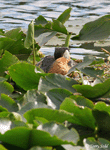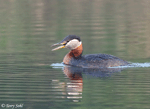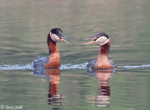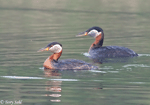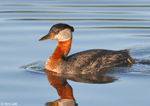| Length: 19 to 20 inches | Wingspan: 32 inches | Seasonality: Summer |
| ID Keys: White-cheeked head with black cap, reddish neck, long yellow bill | ||
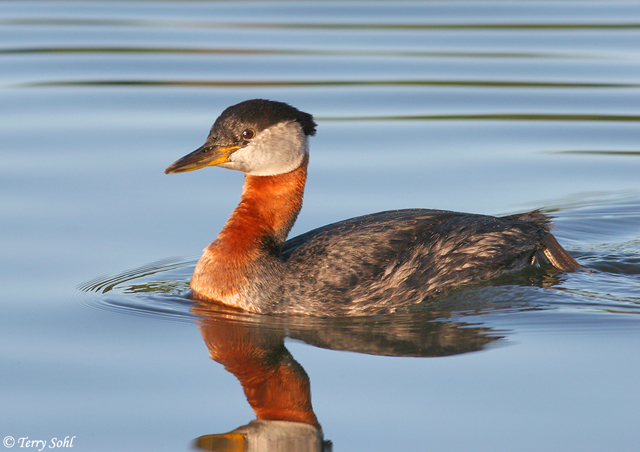 The
Red-necked Grebe is a large grebe that nests in the northeastern part of South
Dakota, where they are typically found in shallow water lakes and marshes. Their
habitat choice changes in winter to a very strong preference for coastal salt
water areas. Red-necked Grebes are often a relatively tame bird, often allowing
close approach by humans, and even regularly breeding in some urban ponds and
reservoirs. Plumage of the Red-necked Grebe is very different between
summer and winter, with the brilliant red neck and bold facial patterns of
summer replaced by more subdued coloring during the winter months.
The
Red-necked Grebe is a large grebe that nests in the northeastern part of South
Dakota, where they are typically found in shallow water lakes and marshes. Their
habitat choice changes in winter to a very strong preference for coastal salt
water areas. Red-necked Grebes are often a relatively tame bird, often allowing
close approach by humans, and even regularly breeding in some urban ponds and
reservoirs. Plumage of the Red-necked Grebe is very different between
summer and winter, with the brilliant red neck and bold facial patterns of
summer replaced by more subdued coloring during the winter months.
Habitat:
On their summer breeding grounds, Red-necked Grebes are generally found in areas of shallow water, including shallow ponds and lakes, the margins of larger and deeper water bodies, or in freshwater marshes. Typically they prefer areas with a mixture of both open water and wetland vegetation. In winter, they are primarily found on salt water, generally near the coastline. Some may overwinter on large inland lakes.
Diet:
Small fish, insects, crustaceans, mollusks, tadpoles, leeches, and occasionally plant material.
Behavior:
Forages by swimming along the water's surface, and periodically diving below the water and propelling itself by its feet in search of food, or plucking food items from the surface of the water. Red-necked Grebes will often partially submerge its head in search of food, and dive once food is spotted.
Nesting:
June and July on their breeding grounds. Red-necked Grebes typically nest alone in individual pairs, although multiple pairs may sometimes be present in the same general vicinity. The nest is a mound of floating vegetation, constructed of reeds and other wetland vegetation, and typically anchored to underwater vegetation or a log or stump. The female lays between 2 and 7 eggs, with both parents helping to incubate them. The young hatch after about 3 weeks, and are able to swim alone shortly thereafter. They also spend quite a bit of time on their parents backs during the first week or two of life. Both parents tend to the young and help feed them.
Song:
Courtship songs are a series of chattering notes, honking, screeches, and other vocalizations.
1Click here to hear the courtship vocalizations of a Red-necked Grebe, recorded in Germany.
2Click here to hear the chattering calls of a Red-necked Grebe, recorded near Anchorage, Alaska.
3Click here to hear the display vocalizations of a Red-necked Grebe, recorded in Finland.
Migration:
Summers in selected locations in the northern U.S., and through much of Canada and Alaska. Generally winters along U.S. and Canadian coastlines, with some occasionally wintering inland (especially around the Great Lakes).
South Dakota "Hotspot"
Not a common bird by any means, they do breed in small numbers in the northeastern part of the state. Waubay National Wildlife Refuge, nearby Enemy Swim Lake, and other similar lakes and marshes in the Prairie Potholes of northeastern South Dakota are places to check out during the summer months.
Interactive eBird Map:
Click here to access an interactive eBird map of Red-necked Grebe sightings
Similar Species:
Very distinctive in breeding plumage, with the strong facial pattern and red neck making it unmistakable. However, in winter plumage they could potentially be confused with the following species:
- Common Loon - The general shape and large bill may make a winter-plumaged Red-necked Grebe appear similar to a winter-plumaged Common Loon, if not seen well. However, while both have rather large, dagger-like bills, the Common Loon's bill is gray with a slight "kink", while the Red-necked Grebe has a yellow, more uniformly shaped bill. The dark cap and white face are more distinct on a Red-necked Grebe, while a Common Loon has a much less distinct boundary between dark upper parts and whiter lowerparts.
- Horned Grebe - The bill of a Red-necked Grebe is much larger than that of a Horned Grebe. Horned Grebes are also much smaller and have a short neck compared to a Red-necked Grebe.
- Western Grebe - Both share a yellow bill, dark cap, and white face and front of the neck (with winter plumage Red-necked Grebe). However, the bill of a Western Grebe is much thinner, the black cap darker, and the white on the neck much more extensive than a winter-plumaged Red-necked Grebe.
Status:
Overall populations are generally thought to be stable. They are found over a very broad geographic area, and numbers are strong in several parts of their range. However, there are conservation threats in parts of their range. As noted by the IUCN, the Exxon Valdez disaster took a heavy toll on local populations of Red-necked Grebe. The species also has been noted to be susceptible to gill nets, which ensnare the birds when they're diving for fish. As with many species, disturbance and habitat loss may reduce suitable nesting and foraging habitat. However, overall the IUCN lists the Red-necked Grebe as a species of "Least concern".
Further Information:
1) USGS Patuxent Bird Identification InfoCenter, Red-necked Grebe
2) Audubon Guide - Red-necked Grebe
3) Whatbird.com: Red-necked Grebe
Photo Information:
June 24th, 2006 - Near Anchorage, Alaska - Terry Sohl
Additional Photos:
Click on the image chips or text links below for additional, higher-resolution Red-necked Grebe photos.
Audio File Credits:
1Joe Klaiber, XC243652. Accessible at www.xeno-canto.org/243652
2Frank Lambert, XC353484. Accessible at www.xeno-canto.org/353484.
3 Eetu Paljakka, XC375848. Accessible at www.xeno-canto.org/375848
| Click on the map below for a higher-resolution view |
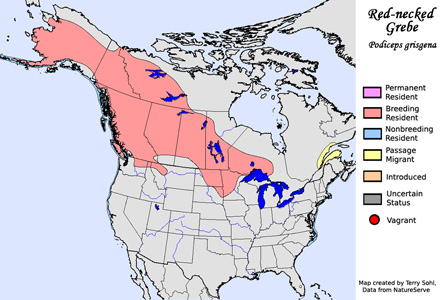 |
| South Dakota Status: Rare migrant in the eastern part of the state, only a handful of records in the western part. Uncommon summer breeder in the northeastern corner of the state. |
Additional Red-necked Grebe Photos
Click for a higher-resolution version of these photos

